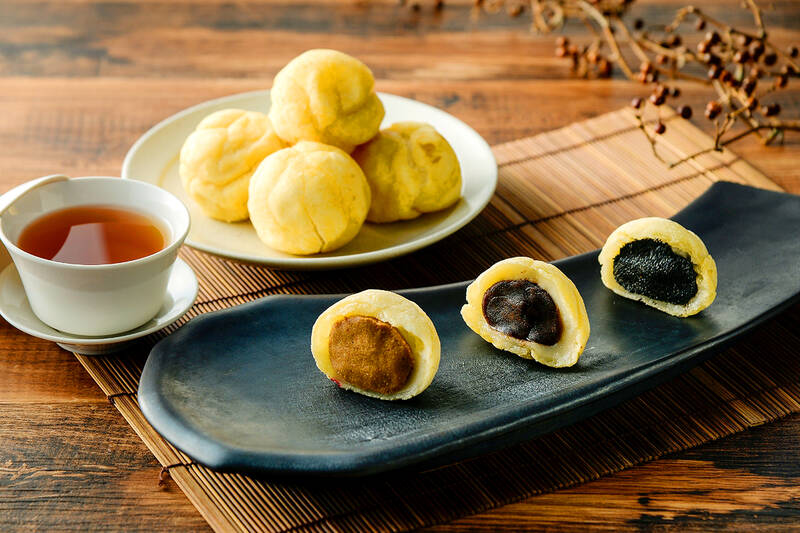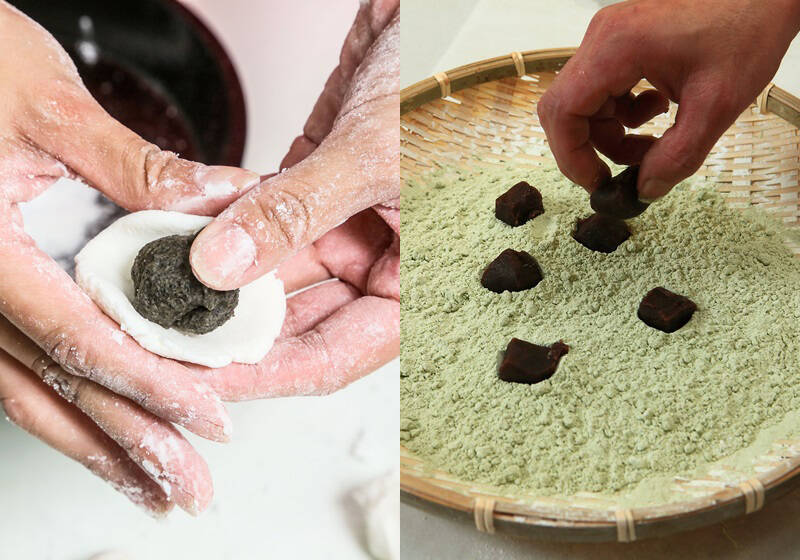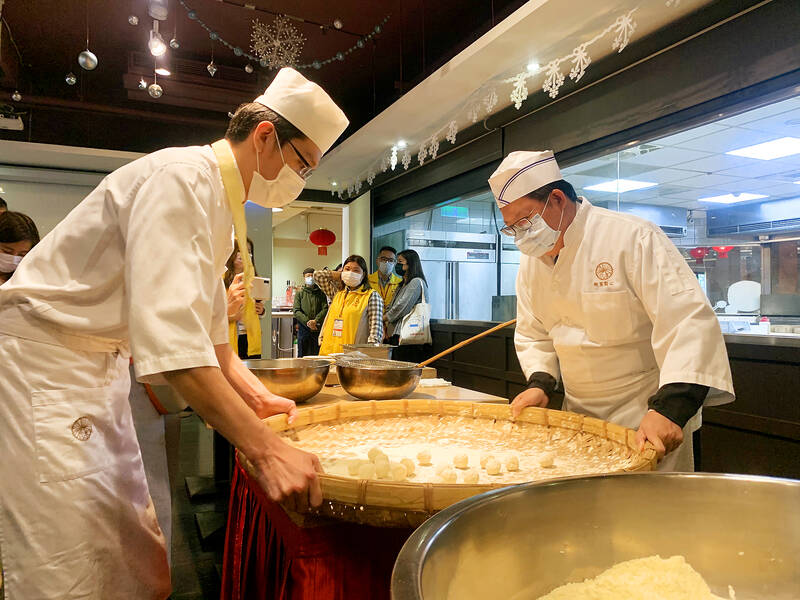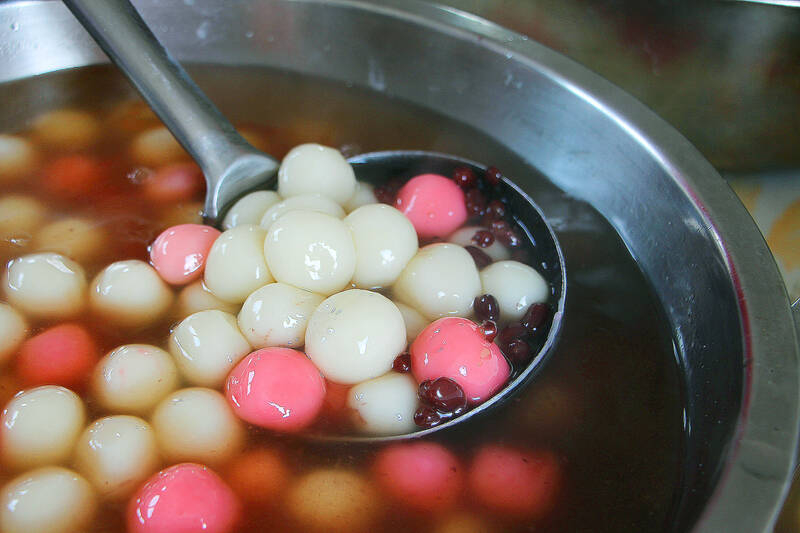Eating glutinous rice balls during the Lantern Festival
Lunar New Year celebrations traditionally conclude with the Lantern Festival, which is on the 15th day of the first lunar month. With every household decorated with lanterns and streamers, the Lantern Festival can be seen as an extended New Year celebration.
Lighting lanterns during the Lantern Festival can be traced to the Western Han Dynasty in China. The 15th day of the first lunar month is the first full moon of the year, and has the significance of a new start. People light lanterns to pray for a bumper harvest in the coming year.

Photo courtesy of Ambassador Hotel Kaohsiung 照片:高雄國賓飯店提供
Since the Song Dynasty, the custom of eating glutinous rice balls during the Lantern Festival has taken shape and has been passed down to today. People often associate tangyuan (glutinous rice balls) with two festivals, the Winter Solstice and the Lantern Festival. Eating glutinous rice balls on these two festivals symbolizes the auspicious meaning of family reunion and success in all aspects of life. However, the glutinous rice balls (yuanxiao) eaten on the Lantern Festival are actually a bit different from those commonly seen on the market. The two are often confused, and many people cannot tell them apart. Indeed, many have never eaten real yuanxiao at all.
Yuanxiao or Tangyuan?
Both tangyuan and yuanxiao have glutinous rice as their main ingredient, differing mostly in the way in which they are made. Traditionally, in southern China, tangyuan and yuanxiao are regarded as the same thing, produced by kneading glutinous rice flour and water into a round shape. While the method used in northern China is different — glutinous rice flour is spread on a bamboo sifter, with the stuffing cut into small pieces placed onto the sifter and shaken so that they will be covered in the rice flour, producing the “yuanxiao.” Due to its geographical location and ethnic groups, Taiwan has inherited the southern method of stuffing and rubbing the glutinous rice balls, and these are the glutinous rice balls that we are now familiar with.

Photo: Liberty Times 照片:自由時報
The nature of the fillings differs according to local customs. In addition to the traditional small red and white glutinous rice balls without fillings, there are also bigger rice balls with sweet fillings, and “savory glutinous rice balls” wrapped with meat in Hakka culture. Most of the yuanxiao have sweet fillings such as sesame, bean paste and peanuts. In China’s Zhejiang Province, there are even rose-flavored glutinous rice balls.
(Translated by Lin Lee-kai, Taipei Times)
元宵節為什麼要「吃圓仔」?

Photo: Chen En-hui, Liberty Times 照片:自由時報記者陳恩惠
傳統上,春節要到元月十五的「元宵節」才算正式結束。元宵節家家戶戶張燈結綵,可說是慶賀新春的延續。元宵點花燈的習俗最早可溯自西漢時期,因農曆正月十五是一年當中第一個月圓夜,有著「一元復始」的意味,人們便會點亮花燈祈求整年的豐收。
自宋朝開始,元宵節「吃圓仔」的習俗便漸漸形成、流傳至今,一般人講到湯圓便會直覺地聯想到冬至與元宵節兩個節日;取圓仔的外型、諧音,在這兩個節日吃湯圓都象徵了闔家團圓、諸事圓滿的吉祥意味。不過,元宵節吃的「圓仔」其實跟市面上常見的湯圓不大相同,兩者常常讓人搞不清楚,許多人更是根本沒吃過真正的元宵。
元宵?湯圓?

Photo courtesy of New Taipei City Government 照片:新北市政府提供
湯圓和元宵的主要食材都是糯米,最大的差異在「製作方式」:傳統上,南方把湯圓和元宵視為同樣的食物,是用糯米粉加水揉捏成圓形;而北方的做法則不同,會在竹篩中鋪上糯米粉,再將切成小塊的餡料放入篩中「搖」,在滾動的過程中便會裹上糯米粉,漸漸成形,就是所謂的「元宵」了。台灣因地理位置、族群的關係,自然而然承襲了「搓」湯圓的做法,便是我們熟悉的湯圓囉!
至於是否含有內餡,依照各地習俗有不同的做法,湯圓除了傳統無餡的紅白小湯圓外,也有加入甜餡料的「圓仔母」、客家文化中包了鮮肉的「鹹湯圓」;而元宵多是芝麻、豆沙和花生等甜口味,在中國浙江一帶,甚至還有玫瑰味元宵呢!
(自由時報)

Renhe sat stiffly at the Wei Ya banquet, picking at the symbolic dishes on the table. Fish for abundance, sticky rice cake for progress — it all seemed superstitious to him. The shrine to the Land God near the entrance, adorned with offerings, incense, and fruit, struck him as frivolous. “What does this have to do with running a business?” Renhe scrolled on his phone as his co-workers performed skits and poorly sung songs. He wasn’t even paying attention to the lucky draws when his name was called. The room filled with applause and cheers as he went to the stage

Stonefish may not be the most impressive-looking animal in the sea. In fact, this fish is so skilled at camouflage that most people wouldn’t notice it if they swam past it. Despite their unremarkable appearance, stonefish are the most venomous fish in the ocean. Stonefish come in various shades of brown, red, yellow, and orange. Their rough skin texture and blotchy color pattern give them a remarkable resemblance to stones, which is where their name comes from. This feature helps them blend in with their surroundings exceptionally well. Stonefish are notable for their 13 highly venomous spines which protrude

「雙手合十/合掌禮」(namaste) or 「碰肘/擊肘」 (elbow bump): 新冠肺炎流行逐漸改變現代社會的某些社交禮儀,歐美許多名人政要開始以「雙手合十/合掌禮」(namaste) 或「碰肘/擊肘」(elbow bump) 替代握手。 《今日商業》報導英國王儲查爾斯以「雙手合十」代替握手。 Coronavirus update: Prince Charles spotted greeting people with namaste (Business Today , March 12, 2020) 另外,《商業內幕》報導:疫情期間美國總統川普在白宮舉行新冠肺炎記者會,想和居家照護公司LHC集團執行副總葛林斯坦 (Bruce Greenstein) 握手,葛林斯坦婉拒,示意改用擊肘。 President Donald Trump attempted to shake hands with a home health care company executive . . . but the man turned the president down and offered him an elbow bump instead. (Eliza Relman, Business Insider , March 14, 2020) 「雙手合十/合掌禮」源自印度,也流行於泰、緬等國家。「碰肘/擊肘」則是 2006 禽流感、2009 豬流感後逐漸流行。疫情逐漸改變我們的生活方式,包括打招呼等社交禮儀,也出現了微妙的變化。 「拱手禮」(fist-and-palm salute) 至於華人社會傳統上也有雙手互握合於胸前「拱手禮」(fist-and-palm salute)。公益網站 Just Quarantine 提到: Taiwanese president Tsai Ing-wen demonstrating social distancing through use of a traditional Chinese greeting (fist & palm) instead of shaking hands in response to the COVID-19 pandemic. 因應新冠肺炎疫情,2020 當年總統蔡英文與來訪賓客保持安全距離,拱手 (fist &

The cocoa industry is currently facing a crisis, with this year’s cocoa trading price soaring to an unprecedented $10,000 per ton—a 400 percent increase from last year—stemming from diminished crop yields. Given cocoa’s indispensable role in chocolate-making, this surge has driven up chocolate prices and triggered concerns about the sustainability of global chocolate production. West Africa, home to over half of the world’s cocoa trees, is at the center of this issue. The Republic of Cote d’Ivoire and the Republic of Ghana, in particular, are facing severe challenges from both natural disasters and human-induced factors, substantially impacting cocoa harvests. Climate change, with